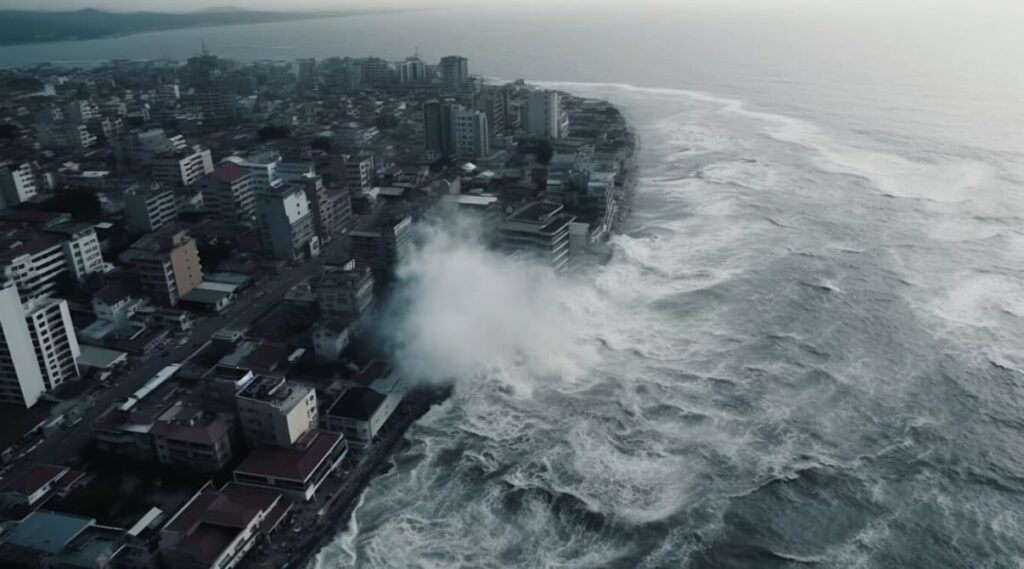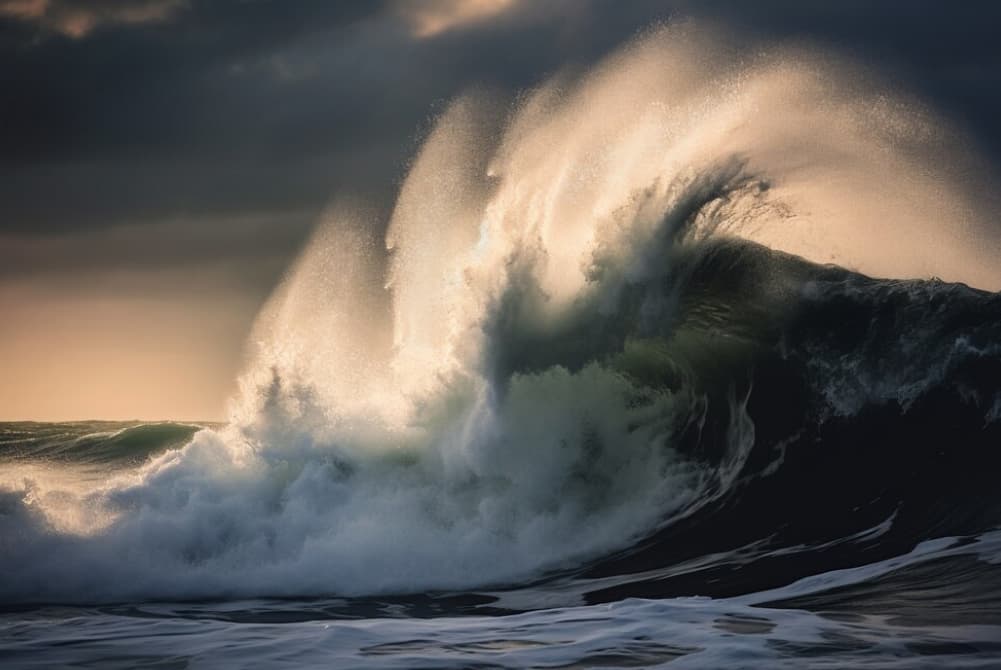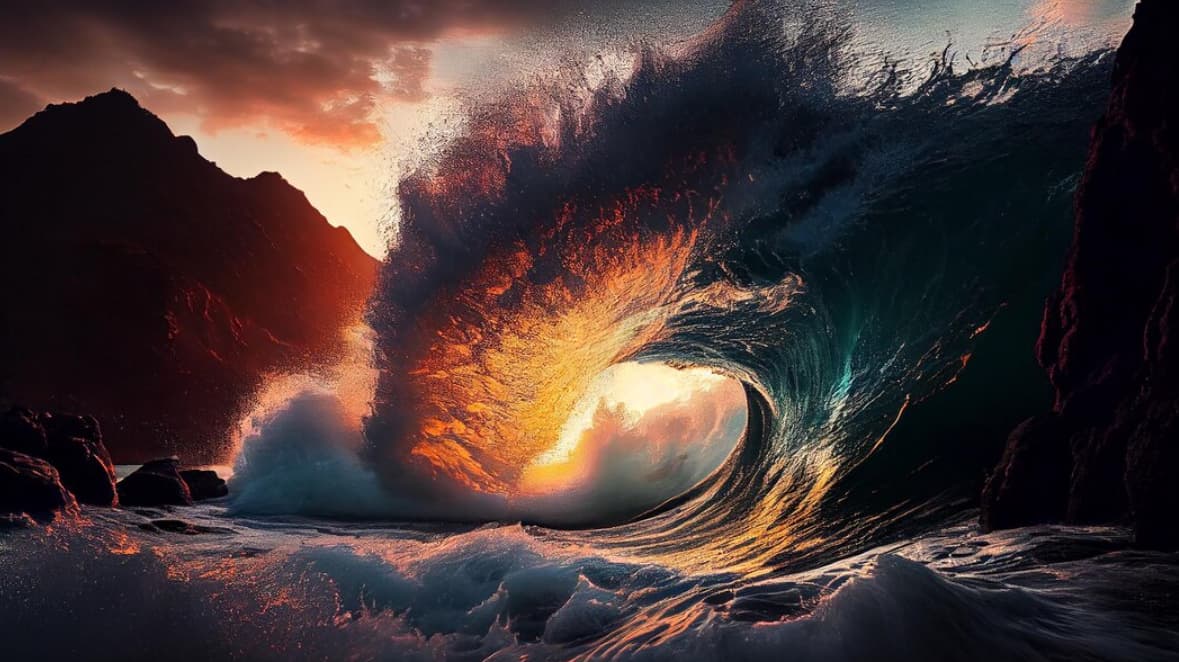Tsunamis and mega-tsunamis are awe-inspiring natural phenomena that can wreak havoc on coastal regions. Triggered primarily by seismic activity such as earthquakes or underwater volcanic eruptions, these massive waves have the potential for catastrophic consequences. In essence, a tsunami manifests as a succession of towering waves, propelled by the immense energy released from subsea disturbances. Delving deeper into their mechanisms and implications is crucial for comprehending the scale of their impact and implementing effective mitigation strategies.
Origins and Impact of Tsunami Waves
- Tsunami waves originate in the vast expanses of the open sea, often far from the coastline;
- Their journey toward land sees them gaining immense size, with their heights escalating as they transition from the deeper parts of the ocean to shallower coastal waters;
- This increase in height, coupled with their velocity, determines the potential devastation tsunamis can cause, with some transforming into colossal megatsunamis.
These formidable waves are capable of achieving speeds up to 500 miles per hour and can ascend to extraordinary heights, sometimes reaching several hundred feet. The record-setting tsunami, observed in Lituya Bay and the Gulf of Alaska, soared to an astonishing height of 1,720 feet. Despite their potential for destruction, tsunamis are relatively infrequent phenomena.
The Pacific Ocean is the birthplace of approximately 80% of the globe’s tsunamis, largely due to the seismic activities along the Pacific Ring of Fire—a zone encircling a significant number of tectonic plates. On average, tsunamis make their presence known once or twice annually worldwide, but the most catastrophic events are even less frequent, occurring roughly every fifteen years. Regions such as Japan, the Pacific Northwest, Alaska, Hawaii in the USA, along with Indonesia, the Philippines, and Chile, are among the areas most vulnerable to these natural disasters.
What Causes a Tsunami?

Tsunamis, colossal waves with devastating potential, are triggered by a variety of natural phenomena primarily including underwater volcanic eruptions and earthquakes. These cataclysmic events transfer immense energy to the surrounding water masses, propelling waves of staggering proportions across vast distances. The resulting tsunami waves exhibit diverse patterns of movement, ranging from unidirectional surges to radial dispersion originating from a central source. Delving deeper into the causes and dynamics of tsunamis unveils the intricate interplay between geological forces and oceanic behavior, shedding light on the profound consequences of these natural disasters.
Exploring the Phenomenon of Mega-Tsunamis
A mega-tsunami represents an extraordinary manifestation of nature’s power, characterized by immense waves surpassing the scale of conventional tsunamis. One notable instance is the devastating Indian Ocean tsunami of 2004, renowned for its unprecedented force and widespread impact. Defined by their exceptional magnitude, mega-tsunamis defy a singular scientific classification due to their infrequent occurrence and diverse triggering mechanisms. These catastrophic events can stem from various sources, including the displacement of water caused by massive objects entering the ocean, such as meteorites or landslides.
The initial surges of a mega-tsunami are monumental, towering hundreds to thousands of meters in height. The historical record bears witness to staggering examples, such as the colossal wave generated by a strike-slip earthquake in Alaska, resulting in the largest documented tsunami to date. In Lituya Bay, an astonishing 90 million tons of rock and ice plunged into deep waters, instigating a wave that soared to an unprecedented height of 1,720 feet.
Contemporary scientific discourse contemplates potential mega-tsunami scenarios, notably centered around the Canary Islands. Speculation revolves around the volcanic activity of La Palma, raising concerns of a seismic event capable of unleashing a monumental wave destined for the eastern shores of the Americas. As researchers delve deeper into the complexities of tsunamigenesis, understanding and preparing for the cataclysmic potential of mega-tsunamis remain imperative for coastal communities worldwide.
The Most Formidable and Lethal Tsunamis
Among the annals of natural disasters, the Indian Ocean tsunami of 2004 stands as a harrowing testament to the destructive power of nature. Unleashing its fury following a seismic upheaval near Sumatra, this cataclysmic event claimed an estimated 225,000 to 300,000 lives across fourteen nations. Triggered by a colossal 9.1 magnitude earthquake, the tsunami surged forth with waves reaching staggering heights of up to 100 feet, hurtling towards coastal communities in Sri Lanka, India, Indonesia, Thailand, and beyond.
The initial impact was swift and devastating, with the city of Banda Aceh on the northern shores of Sumatra bearing the brunt of the onslaught just 20 minutes after the quake struck. It’s estimated that nearly 100,000 lives were claimed in an instant. Across the region, the toll of destruction mounted as the waves rippled outward, engulfing coastal settlements in Thailand, India, and Sri Lanka. Tragically, the allure of the receding shoreline drew many unsuspecting victims, including tourists in Thailand, who unwittingly placed themselves directly in the path of the advancing tsunami. In Thailand alone, approximately 5,400 lives were lost, with over 2,000 identified as tourists. Meanwhile, in India, the southeastern coast near Chennai bore the brunt of the onslaught, resulting in the loss of around 10,000 lives.
Remarkably, the devastation of the Indian Ocean tsunami reached even farther afield, extending its reach to South Africa, some 5,000 miles distant from its epicenter in Sumatra. As the stories of these calamitous events unfold, they serve as poignant reminders of the imperative for preparedness and resilience in the face of nature’s most formidable forces.
Tsunami Survival Strategies

Surviving a tsunami hinges on swift and decisive action, starting with earthquake readiness. Prioritize standard earthquake precautions, including the well-known “Drop, Cover, Hold On” protocol advocated by Ready.gov. Swiftly seek higher ground inland, aiming for elevated terrain to maximize safety. Remain vigilant for telltale signs of an impending tsunami, such as unusual ocean water behavior like sudden drainage or the receding waterline. Keep your senses attuned to emergency alerts, staying informed through all available channels.
Given the abrupt and unpredictable nature of tsunamis, adherence to evacuation orders is paramount. Disregard any inclination to remain in your residence, as it offers scant protection against the tsunami’s fury. If caught at sea upon receiving a tsunami warning, steer your vessel away from shorelines and into deeper waters to minimize the risk of being engulfed by the oncoming waves. By prioritizing preparedness and swift action, you can enhance your chances of survival in the face of this formidable natural disaster.
FAQs
A mega-tsunami is distinguished by its initial wave height, which far exceeds that of standard tsunamis. These colossal waves can tower many meters high, sometimes reaching up to a thousand meters or more.
Tsunamis are categorized into distant tsunamis, regional tsunamis, and local tsunamis. Distant tsunamis originate far from the coastline, while regional tsunamis are generated within 1-3 hours’ reach of land. Local tsunamis, on the other hand, are born very close to the shoreline where they strike.
Tsunamis can be triggered by earthquakes, landslides, volcanic eruptions, and extraterrestrial collisions, such as those caused by meteors.
The largest tsunami on record occurred in Lituya Bay, Alaska, in 1958. This monumental event made landfall with an astonishing height of 1,720 feet, leaving an indelible mark in the annals of natural history.
Conclusion
Tsunamis and their larger counterparts, mega-tsunamis, represent some of the most potent natural forces on Earth. Arising from underwater seismic activities such as earthquakes and volcanic eruptions, these colossal waves can span vast oceanic distances, escalating in height and destructive power as they approach the coastline. While they are infrequent occurrences, the devastation they impart underscores the importance of understanding their origins and mechanics. By bolstering our knowledge and preparedness, we can better mitigate the potential threats they pose to coastal communities and ecosystems. Better knowledge, awareness, and effective disaster management strategies are our best defense against these awe-inspiring yet potentially devastating phenomena.



